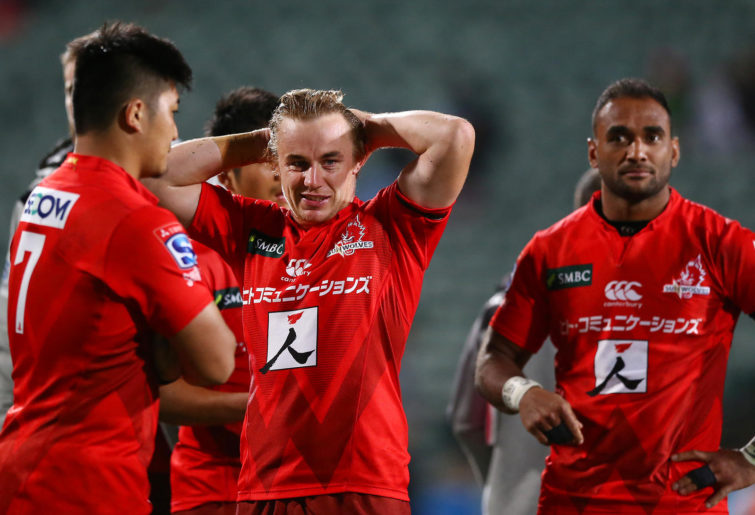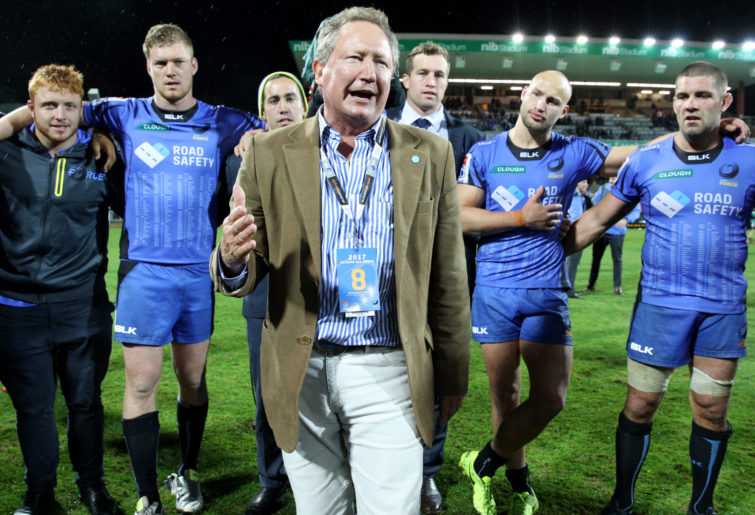The head spins when trying to decipher the power plays that are emerging as global rugby’s landscape gets ready for a sizeable shake-up.
Who needs to work with who to succeed? Is all what it seems, or are there ulterior motives? Where do the financial imperatives end and the public relations pitches start?
Of course, the Super Rugby axing of Japan’s Sunwolves is all just speculation for now as we wait for SANZAAR’s official announcement on the future of the competition later on Friday.
However, it’s all but certain that the Sunwolves – in their fourth season in Super Rugby – will say sayonara from the top-tier southern hemisphere competition at the end of 2020.
The mail is that SANZAAR want to go for a 14-team competition, with a new broadcast deal set to be negotiated to start in 2021.
That would likely result in a return to a round-robin format, meaning the end of the unpopular conference system.
Simpler. Easier. It’s apparently what the fans have been telling them in their marketing surveys and focus groups.

Hayden Parker reacts after a Sunwolves loss. (Photo by Anthony Au-Yeung/Getty Images for SUNWOLVES)
The speculation is that the Sunwolves might find a home in what could be described as a second-division Asian Super Rugby competition run in conjunction with Andrew ‘Twiggy’ Forrest’s Global Rapid Rugby.
The demoted Sunwolves would join the Western Force, Fiji, Samoa, Hong Kong, Singapore, Malaysia and potentially a second Australian team.
One of the more intriguing details of the media speculation was that according to the Sydney Morning, the new Asian Super Rugby set-up would be a SANZAAR-endorsed competition part-owned by Forrest, Australia’s mining billionaire.
Why would SANZAAR – an organisation whose members are the South African rugby union, the New Zealand rugby union, Rugby Australia and Argentine rugby union – feel the need to endorse a competition that includes teams almost entirely outside their membership?
The only one that falls inside the catchment membership, the Western Force, is the same one that SANZAAR flicked a few seasons ago.
Needless to say, Force players, fans, coaches and administration would prefer to flick the bird to SANZAAR and Rugby Australia.
But perhaps this has the potential to become a symbiotic relationship.
How? The teams that the Asian Super Rugby competition would consist of are from nations that don’t easily attract a big rugby following.
Even if rugby is Fiji’s national sport, its small population of about 900,000 and being a relatively poor country means their power at the negotiation table is fairly weak.
Idealistic rugby fans might not like it, but these factors matter to administrators as they map out the structures of a new competition.
Maybe more directly these factors matter to broadcasters, who want lots of passionate fans with high disposable incomes to tune in to matches, and advertisements.
Perth, Hong Kong and Singapore include people with high disposable incomes, but their rugby markets are relatively small.
Even Twiggy, with all his business nous and golden touch, would struggle to sell an Asian Super Rugby competition to broadcasters.
The markets are small and they don’t – and won’t – have enough big-name players to give the competition kudos, despite Twiggy’s insistence that they will soon sign a slew of global rugby stars.

Fortescue Metals Group chairman Andrew Forrest (AAP Image/Richard Wainwright)
There’s curiosity and admiration to have the courage to change some rugby rules to jazz up the game and increase ball-in-play time, but it would take a decent gamble for broadcasters to do a deal.
So who could help? SANZAAR, who have a public image problem. They’ve tried their best to spark up Super Rugby through expansion, but it’s been a failure.
They got all bloated, and then had to trim down. The damage was that they peed off not only the folk from Perth, but also players and fans from two South African teams: the Bloemfontein-based Cheetahs and the Port Elizabeth-based Southern Kings. And now, the Sunwolves.
The most ardent critics would say that SANZAAR have treated them as their play things, and then when it hasn’t worked out as they had hoped, booted them to the kerb with little love. There isn’t a whole lot of goodwill from rugby fans towards SANZAAR.
The recent Super Rugby axings have left many to view them as cold-hearted. They’ve been accused of being aloof, with little public communication and interaction.
How could SANZAAR redeem themselves and show the region that they care? How could they prove that they’re not all about banking the biggest broadcast contract, but are sincerely motivated to ensure the health and sustainability of rugby in the Asia-Pacific?
By packaging up two broadcast deals. That is, they go to the negotiating table soon to sell the rights to the new 14-team Super Rugby competition as well as the second-tier Asian Super Rugby competition.
It’s both or nothing. The broadcasters can’t take one without the other.
There are practical reasons why this could work well, particularly in terms of scheduling to prevent overlaps in kick-off times between the two competitions.
The member unions from Hong Kong, Singapore, Malaysia, Fiji and Samoa – along with Twiggy – would surely embrace this kind of collaboration if it eased the financial load of kickstarting their new competition.
It may even mean SANZAAR taking a hit financially to get the Asian competition some media exposure and give it a chance to grow. But it’s a burden they may have to bear, even in the strange circumstances in which only one of the four nations within SANZAAR would have a competing team.
It might prove to be good business to make it their business, because marketing surveys and focus groups wouldn’t be necessary to confirm that rugby fans would want SANZAAR to show some love for their neighbours in the Pacific and Asia.






























































































